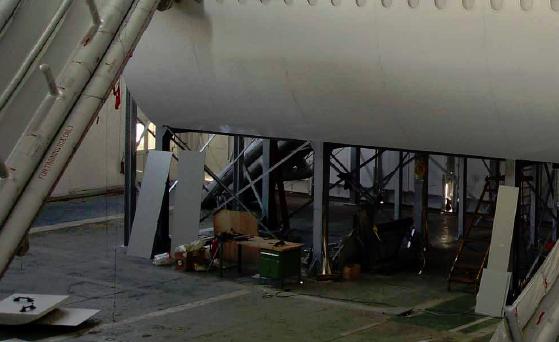
Growth can come from expensive acquisitions, or as with Air Industries Machining, it can come organically by making the business ready for new opportunities when they arise, Alan Swaby learns.
It’s worth remembering on occasion just how fast and how far industry has changed in the last few decades. Dario Peragallo, for example, is far from being alone, but when he set up Air Industries Machining in 1969, to all intents and purposes computers didn’t exist. No Internet, no electronic transfer of data, no numerically controlled machines; just good old-fashioned blueprints and the coordinated skill of hand and eye.
The business started in a garage just outside the gates of Grumman Aerospace in Long Island, picking up whatever machining orders could be gleaned. Nevertheless, company president Peragallo and his partner Peter Rettaliata had the foresight to choose a name for their company that was far more grandiose than its humble beginnings suggested. These days, the company is a wholly owned subsidiary of the publicly listed Air Industries Group, which, together with its sister company Welded Metallurgy Inc., operates as a Tier 1 or 2 supplier to the likes of Sikorsky, Northrop Grumman, Boeing, Lockheed and Goodrich.
“The company’s history has been one of managing change,” says CEO Rettaliata. “The aero industry has developed in tandem with the development of computers. In Dario, we were fortunate to have someone interested in computers and capable of building his own in order to be one of the first in the country to use the Internet when AOL first introduced the concept. The IT side of things has been the least of our worries.”
In fact, in a poor man’s version of the supply chain management tools employed by aircraft manufacturers who instruct suppliers via an Internet portal on what and when components should be delivered to the production line, Peragallo has instigated his own home-grown package to control those parts that Air Industries Machining has subcontracted out.
Staying one step ahead of developments has been an ongoing key to AIM’s success. Long before the concept of supply chain relationships had entered the industry’s vocabulary, AIM was using every opportunity offered to expand the scope and complexity of supply. Where once AIM was content with parts valued at hundreds of dollars, it’s now supplying complete subassemblies worth tens of thousands of dollars and involving both mechanical and electrical subassemblies alongside the core competency of precision machining. This opportunity of growing into a more vertically integrated business has been possible thanks to the trust and faith it has instilled within customers.
“In the early days,” says Peragallo, “the aero industry was a bit rough and ready. All customers really wanted was a quality product delivered on time. Our business had the machines out back and a bookkeeper in the front office. But change came in the form of more complex airplanes and higher levels of accountability and traceability in everything produced. Suppliers unwilling to invest in greater engineering and purchasing infrastructure were left by the wayside. As manufacturers have reduced their vendor base, it’s been necessary to demonstrate a willingness to do more in order to make the next cut.”
The common denominator in the factory’s output is that they tend to be flight, safety or fracture critical parts. AIM has carved something of a niche for itself in landing or arresting gear. Parts can vary in size and complexity from something as small as a brace assembly to the complete drag strut assembly—10 feet in length and 7 feet wide—that goes on Goodrich landing gear for the A380.
AIM is often called in at the prototype stage, where it helps engineers finalize their designs with advice on how best parts can be made. Sikorsky awarded AIM the contract to build a new throttle quadrant to operate the S-76 engines before completion of the final design. Sikorsky also relied upon Air Industries to fabricate the prototype on an assembly containing over 200 details in the bill of materials, including electronic integration. In so doing, AIM was able to influence the final design with many suggestions on how it should be produced.
Where initially the business started with two Bridgeport lathes, there are now over 50 principal machining centers (including 5-axis equipment), some much larger than the original garage where the business started. Currently the 76,000-square-foot facility is home to around 175 employees, generating sales of around $40 million a year.
“The Long Island location,” says Rettaliata, “is a double-edged blessing. We’re in the heart of the aerospace industry making us close to customers and surrounded by skilled engineers and tradesmen who understand the aviation business. But it’s an extremely expensive area, which means we have to be very careful about overhead and expenses.”
AIM spends about $1 million a year on updating its inventory, but it often buys second-hand machinery at auction and makes its own modifications to give it the customized capabilities needed to suit the work at hand.
At the same time, working lean has been a priority within the organization for a decade or more, to the extent that in 2004 it was Northrop Grumman’s supplier of the year and gained United Technologies’ MBE Excellence award. “But there’s a lesson to be learned,” admits Peragallo. “One of the 5S’s is sustainability, and we learned the hard way that you can’t rest on your laurels. After getting the business into its best shape in 2004, other demands meant that I took my eye off the ball and our performance subsequently suffered. We’ve now hired a permanent continuous improvement manager to take over responsibility, but the truth is, it’s something we ought to have done five years ago.”
Peragallo and Rettaliata are already planning for the next anticipated shift in the way the business will operate. Despite having input on how the design develops, AIM currently works to supplied details. But they can see the day when responsibility for design will be handed over to suppliers, and they, once again, want to be ahead of the game. www.airindustriesgroup.com













